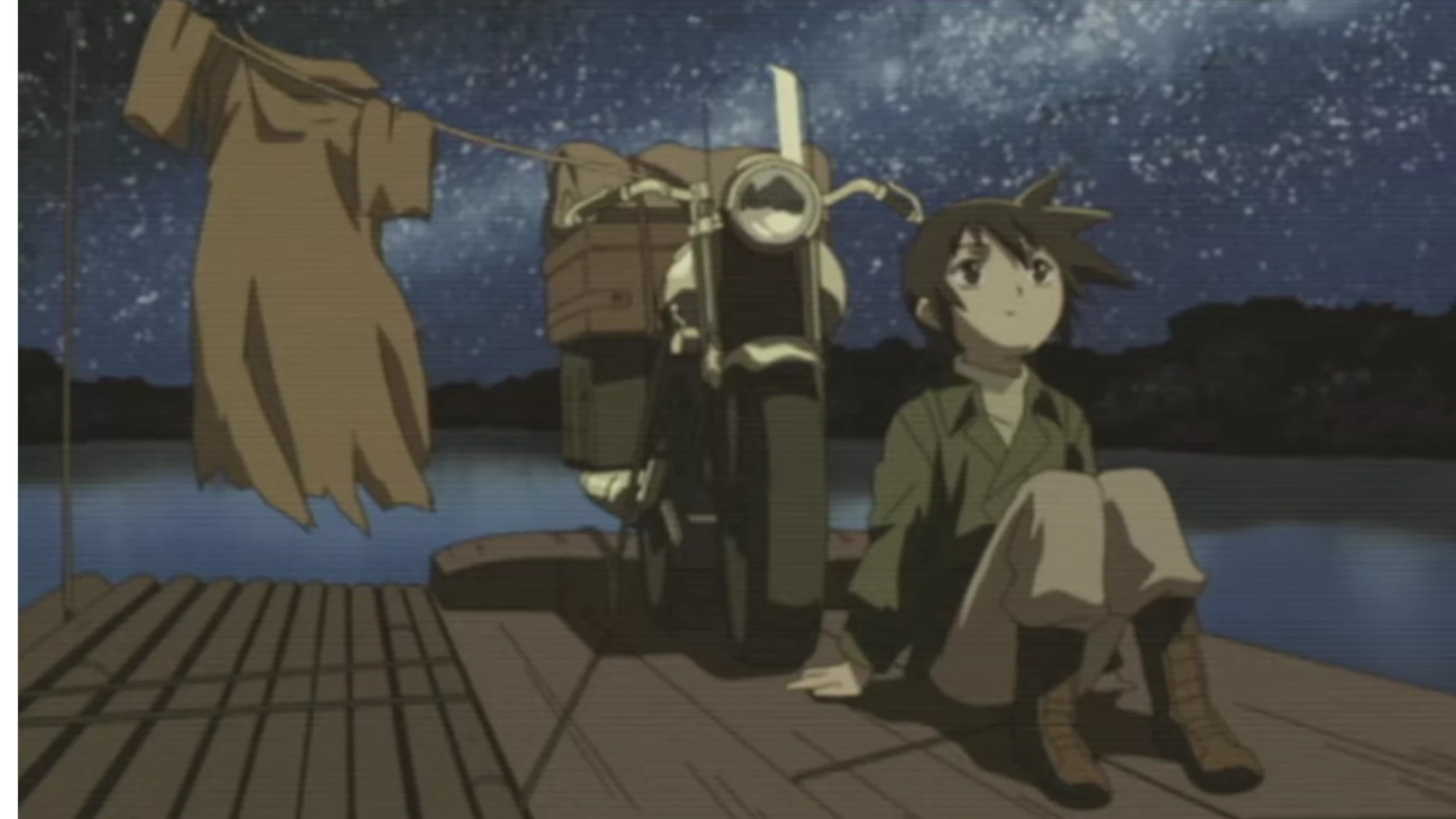paranoidphantom
2 February 2025
Kino no Tabi: The Beautiful World (Review) [Anime]

Source: Kino no Tabi: The Beautiful World
Release: 2003
Episodes: 13
Kino no Tabi: The Beautiful World is a short 13-episode series that tells the story of a girl named Kino and her talking motorcycle, Hermes, as they travel through various lands. Along the way, they encounter many people—some good, some not so much. Their journey is filled with exciting events, as well as mundane ones that are simply part of a nomadic life. If you have the soul of a wandering adventurer, let’s take a look at Kino’s travel notes together!
City-States and Their Internal Affairs
The main characters in this anime are travelers—a rare occupation in their world, yet one that is respected in many countries. Moving from one city-state to another (as that is how countries are structured in this world), Kino and Hermes encounter unique customs and ways of life. Often, they find themselves caught in the disputes of the locals, but they usually choose not to interfere, remaining mere observers of unfolding events.
Considering that the anime seems to take place in a setting reminiscent of the early 20th century, the city-states are deeply rooted in their traditions. There is no such phenomenon as globalization in this world. Because of this, every time Kino and Hermes arrive in a new country, they are met with people who have their own distinct philosophies.
Throughout their journey, they will visit a country inhabited only by telepaths, a nation destroyed by revolution, a land awaiting the end of the world, a country where the coliseum has replaced the parliament, and a place where citizens no longer die in wars.
Together with our inseparable duo, we will mostly act as detached observers. The strangeness, absurdity, or even brutality of local customs is part of the beauty of this world—contrasts and unpredictability are the spice of life after all.
Traveling as a Way of Life
A traveler is defined by their journey. If they stop traveling, they cease to be a traveler. Kino understands this well, which is why she follows a strict rule: she never stays in one country for more than three days. Any longer, and she might be tempted to settle down permanently. For a traveler, that is unacceptable.
The backstory of how Kino met Hermes and became a traveler is also intriguing. I won’t spoil it in detail, but I will say this: perhaps the reason there are so few travelers in this world is that almost everyone has a place they call home. Who among us would willingly abandon comfort for the sake of new experiences? But for Kino, who has lost her way back home, moving forward is the only option. For her, traveling is the only way to live.
Good, Evil, and a Trusty Revolver
At its core, traveling is a way of understanding the world. We experience its diversity firsthand. In this whirlwind of contrasts, it is easy to lose oneself. What is good, and what is evil? How do we distinguish lies from truth, or the righteous from the misguided? Each new country tests Kino’s personal ideals and values.
They say, “When in Rome, do as the Romans do,” but Kino does not seek to conform to the customs of the lands she visits. She prefers to remain distant and detached—she has her own philosophy, the philosophy of a traveler. By maintaining near-complete neutrality, she preserves her identity while wisely avoiding imposing her worldview on others. Like a naturalist studying an anthill, she carefully observes without disrupting the balance of power or traditions. However, even neutrality sometimes needs to be defended. For such occasions, Kino carries a set of persuaders.
Format, Style, and Atmosphere
Structurally, the anime is an anthology—there is no overarching plot. Each episode tells one or two stories, usually connected by a common theme. However, this is neither a slice-of-life series nor a typical road movie (unlike, say, Sousou no Frieren). Instead, Kino no Tabi feels more like a collection of parables with philosophical undertones—somewhat reminiscent of Sonny Boy.
This anime is intelligent and mature. There is virtually no humor, and the storytelling is consistently serious. Moreover, much is left unsaid. We don’t know the full details of the world, we don’t always see the consequences of certain events, and the fates of many people and places remain unknown. The world exists beyond our perspective; events unfold around us, and we, just like Kino, are not omniscient observers. This leaves ample room for personal interpretation and analysis. If you enjoyed Haibane Renmei, you will likely appreciate Kino no Tabi as well.
I feel that Kino no Tabi embodies the essence of mid-2000s anime. Many series from that era shared this aesthetic: soft beige tones, quiet protagonists, philosophical themes, a touch of mysticism, and an unusual soundtrack. Kino no Tabi is a quintessential representative of that period, checking all the boxes of popular mid-2000s anime tropes.
Lastly, I must mention an interesting visual technique: the anime features artificial scanlines—horizontal lines mimicking the effect of old CRT monitors. Though undeniably a digital production, even back in 2004, Kino no Tabi made every effort to look vintage and analog.
Conclusion
Kino no Tabi: The Beautiful World is not a flashy anime, but rather one with a dense autumnal atmosphere and deep philosophical reflections. If you are still searching for yourself or if the spirit of a frontier explorer still burns within you, I highly recommend giving this anime a watch.